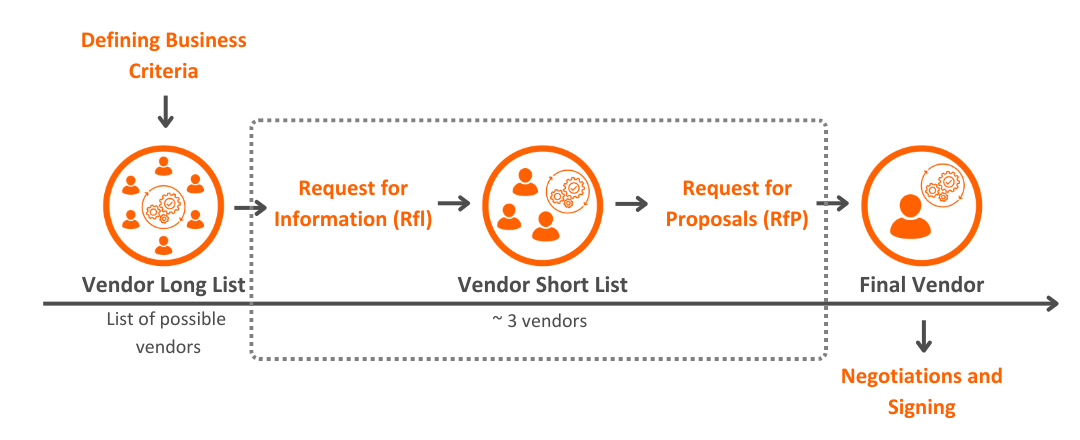How do you select the right Clinical IT vendor?
by Pauliina Ranne – Senior Consultant
 Overview
Overview
Choosing a fit-for-purpose clinical IT solution might initially seem like a taunting task whether it is a first-time implementation or replacing an existing system. How to gather the correct information? How to ensure that the vendors’ strengths and weaknesses are properly identified in the process?
At HERAX we have extensive experience with selecting the right vendor. We know the market and have experience with a vast majority of IT vendors used in the pharmaceutical and medical device industry. Our clients benefit from our expertise in life science, operational processes, information technology, and pharma architecture methodology. By utilizing our vendor selection methodology for the Request for Information (RfI), Request for Proposal (RfP), and general scoring of the vendors, we can ensure that you select the right fit to your organization’s processes and needs. Below we are going to highlight some of the key aspects to keep in mind in the vendor selection process.

 Defining Business Criteria
Defining Business Criteria
There is rarely one perfect vendor on the market. Therefore, it is important to have a clear understanding of what is essential and non-negotiable for your company’s processes. Investing time in defining business criteria early in the process will help to lay a solid foundation for the entire selection process and will also benefit in the implementation phase. These criteria will guide the selection from identification of potential vendors to scoring of the selected ones.
 Engagement of stakeholders
Engagement of stakeholders
Ensuring engagement from the stakeholders is essential throughout the process. Afterall, end users are the ones who will be using the system which makes them best qualified to define which functional properties the system should contain. The more committed the end users are from the beginning, the higher the chance that the most suitable systems will be filtered out to demonstrate their systems.
Additionally, including IT experts in the selection process can hugely benefit the selection process by ensuring a thorough assessment of the system’s technological aspects and long-term sustainability. Poor technical capabilities have the potential to increase the total cost of ownership by, for example, increasing the time and effort for building integrations or in the worst-case scenario having to replace the system sooner than expected due to scalability and performance issues.
 Demonstrating the system
Demonstrating the system
System demos are the vendors’ opportunity to showcase their capabilities and fit, but no sane vendor would willingly choose to exhibit the shortcomings of their system. Therefore, by setting clear expectations and guidelines to the vendors, e.g. in the form of specific use cases which are essential to demo, it is easier to discover if the vendors are not meeting the ‘must-have’ requirements. Having a clear outline for the demos, also simplifies the evaluation process for the business stakeholders by helping them navigate the demos and have a clear overview of what they are scoring.
 Scoring of the vendors
Scoring of the vendors
Vendors should be scored on a variety of criteria. As mentioned above, functional and technical capabilities are clearly important but there’s more to a successful collaboration and implementation. Some additional factors to consider in the process are, for example the total cost of ownership, cultural and professional fit, vendor’s capability to provide support, vendor’s roadmap etc.
With so many criteria to consider, it can be easy to lose sight of how to evaluate vendors on common terms. Thus, the scoring process should be made as simple as possible – the vendor either meets the requirement or does not. Adding excessive granularity to the scoring system might introduce subjective biases, making the results harder to justify and defend objectively.
 Negotiations and signing
Negotiations and signing
The negotiations phase is the final opportunity to perform due diligence on the preferred vendor, i.e. conduct financial assessment, audit, reference calls etc. This is the time to ensure the contract includes clear service level agreements (SLAs), performance guarantees, and penalties for non-compliance. Additionally, addressing data ownership, security, and compliance requirements, and confirming exit strategies for termination or vendor transition.
In this stage, it could also be worth considering whether it would be preferred to start slowly with a proof of concept before committing fully to an implementation project. Doing a proof of concept might also be a good opportunity to build user confidence and set the stage for a soother implementation if successful.
 Conclusion
Conclusion
Vendor selection can be a very straight forward process if it is well planned from the beginning. Creating a methodical and structured process helps internal stakeholders and vendors contribute effectively, ensuring the best IT solution is identified for the organization’s needs.
